Arles on December 2, 2014 is radiant! Surely this is the light so admired by Van Gogh when he first came here in 1888. It's a glorious day for me: brilliant in tone, color, sunlight, taste and depth. May I never forget it. May all the small pieces found here, grow into an even more beautiful collage long after I am gone.
I must remind you, lest you're tempted to take the next flight/train over and find yourself in Arles tomorrow (after reading my glowing introduction): this is an old town. It struck me in studying your comments, that someone may not be so in love with putting up with all that being old involves: not all the shutters and stones are polished, painted or refreshed. The streets are narrow. There are more cracks than smooth surfaces. Gauguin, arriving on Van Gogh's enraptured invitation, promptly admitted to hating it here. (A real slap to Vincent.) And, too, for us, if we venture out during the hours when the town sleeps (midday for lunch, and Mondays because it's Monday, and early in the evening because no French person worth her salt is going to shop past the supper hour), I suppose it can appear forlorn.
Not for me: I'm with Van Gogh. Fact is, living now as I do in the land of the new, I miss the old. I miss the character of irregular structures that share walls imperfectly. Of streets and blocks that don't quite replicate the squares of a chocolate bar. I miss bleak doorways that, when opened, reveal beauty so deep that it overwhelms you. Arles is like that. On a cloudy pouty day it may seem tired. Yes, going back over yesterday's photos, I can see that. But even without today's beautiful light, I am sure I would have been mesmerized. Perhaps not so floored as to sob deep tears of joy (a I almost did, retreating over the river this afternoon), but I still would have loved its tattered exterior for all that it holds back inside. Like a famous someone or other once said -- they don't make 'em like this anymore!
Breakfast. I'm the only guest at Le Patio d'Arles and in fact, after my visit, they're closing for the rest of the year. My hosts, Vincent and Nathalie, join me.
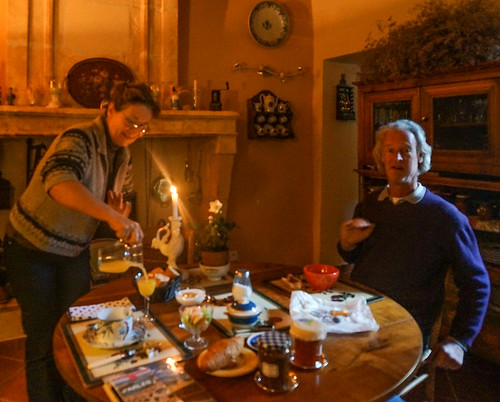
A croissant with her home made jam of apples (from their second home in Normandy) rhubarb and Calvados, yogurt, fresh fruits, juice, and superb coffee.
We discuss whether running a three room B&B is like tending three hens. (I say yes, Vincent protests: he and Nathalie can walk away for a day, a month. And, too, they get a positive kick from interesting guests. I don't admit that actually, I get a positive kick out of our three hens. Of course, Oreo is like a difficult guest. But he's improved!)
Then begins my plunge into the heart and spirit of Arles.
Out the door...
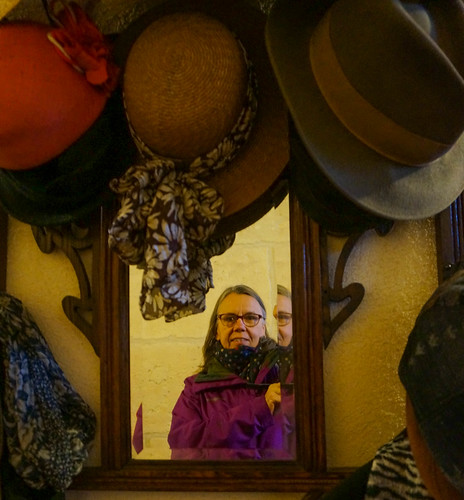
(bundled against a morning chill)
Across the river...
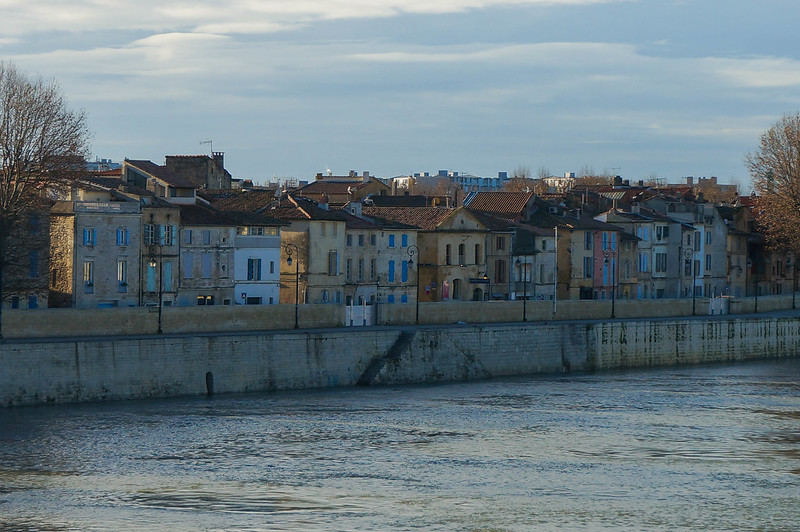
(clouds receding)
Into the yellows and blues of Arles...

I want to start with the Fondation de Van Gogh (once a hospital, where, in fact, Van Gogh stayed, now a center of art) and on my way there, I pass Monsieur Cavico (that's a best guess from seeing his name on his paintings), working on the old stones of a floor. His own canvases are stacked against the garage walls.
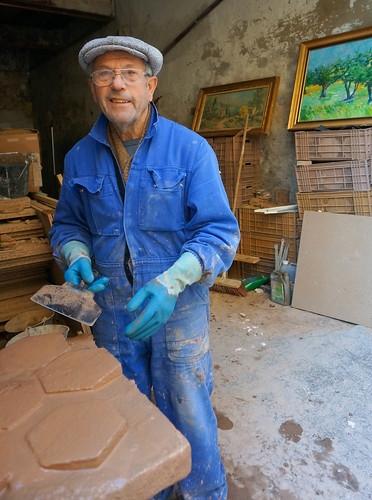
We chat. He is my flesh and blood artist of today -- I run into him (coincidentally) several times and during each encounter, I learn something new about art and Arles. (I also learn about his son, a chef in New York and about a bunch of other details of his life, but what really stayed with me is his pride in work.)
The books say the Fondation opens at 10 in the winter. They're wrong. It's 11.
I go on to my next I-have-to-see-this item: the Eglise St-Trophime.
I pass bakeries...
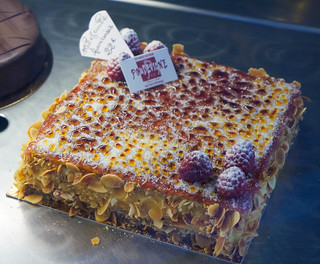
And a shop with wool, where the store owner sells some of her creations...

(what soon to be grandma can resist this handmade piece for a winter baby?)
I come to St. Trophime. The outside portal is the marvel, but I didn't see it and neither will you: it's behind scaffolding right now. Inside -- a beautiful Romanesque interior.

Outside, a stunning 12th century bell tower, against a very blue sky!

But it's the cloisters to the side that really take your breath away (and especially on this day of deep blue skies and streaming sunlight). The added bonus for me -- total quiet. There are no visitors on a midweek morning in December.
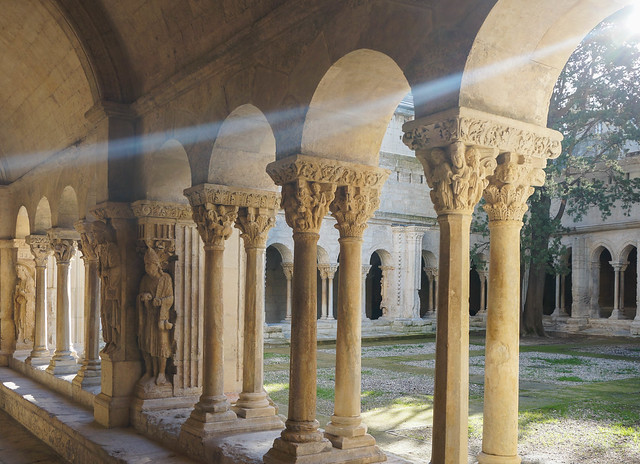
And another bonus -- one that causes me to actually stick up for the people who come here in months other than November and December: Provence is known for the Santon sculpture -- small figurines engaged in traditional tasks, formed and painted by local sculptors. Because this art form began with molding pieces for Nativity scenes, the Santon exhibition at the cloisters abides by the tradition of displaying them only at Christmas time. Even though only a very small number these days have anything to do with Christmas. I protest this, but hey, maybe for the locals, it's reason to schedule a visit here in months when there is very little else that would be a draw. A bit like Christmas markets in northern Europe -- a way to get people hyped about going there during the worst months of the year.
My favorite Santons from the displays:

(note: they're tiny!)
And yes, you can purchase very simple ones for your collection and no, I'm not in a buying mode. I would only purchase one if it was of a woman with a cheeper and if it doesn't cost much. Oh! Both conditions satisfied!

Outside again, I walk along the pedestrian routes and I do some people watching.

(he sings beautiful old melodies)

(Provencal conversations always involve hands; note: pinks and orange!)

(what Ed would never wear: a Provencal hat and a scarf)
Then I return to the Fondation. Van Gogh wanted to create in Arles a community of like minded artists. After a long back and forth, Gauguin finally came to paint with him. No others followed, possibly because Van Gogh was by then so terribly burdened by his mental illness. Gauguin himself left immediately after Vincent severed his own ear.
But they say that Vincent Van Gogh's dream was realized, albeit more than a century later, by the creation of the Fondation, which invites select artist to display their paintings. Right now two are featured -- Yan Pei-Ming and Bertrand Lavier. I watch the film clip as both talk about preparing for the exhibition. I am mesmerized by the interviews! Imagine: you're an artist. You're told you've been selected. How do you cope?!
Yan Pei-Ming began by painting Van Gogh's self-portrait (a painting using a painting as a model) to guide him in the endeavor.

He rejects it for the display. Not the statement he wants to make. Next, he uses the same brush strokes, but creates his own impression of how Vincent may have once looked. (These are on display.)
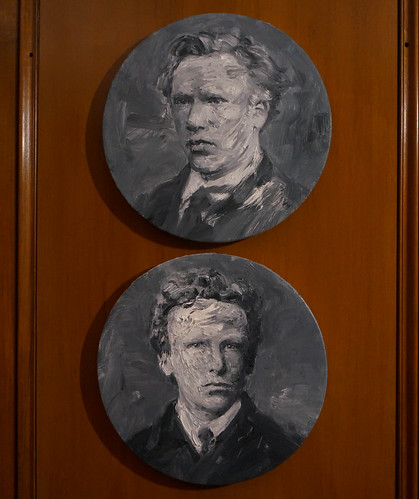
Lavier, the second artist, approached things differently: for him, Van Gogh's brush strokes create the art. And Lavier uses them not only on a canvas. Here's something you might like:
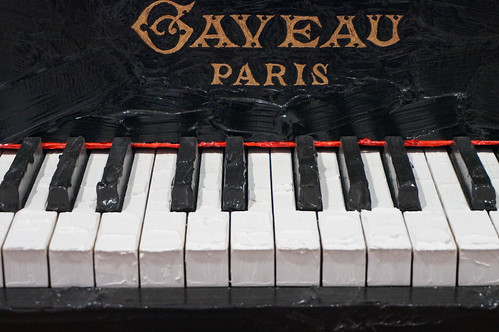
You're thinking -- a painting of a keyboard... But in fact, it's a whole piano, completely painted over with Van Gogh styled strokes!
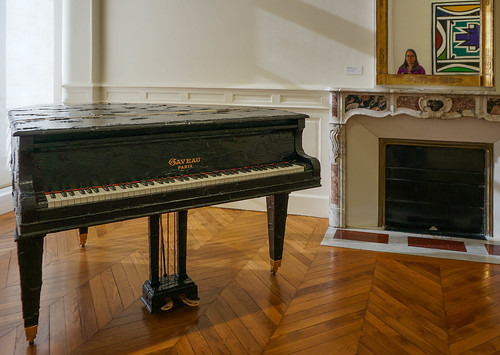
(Ocean author in the mirror)
And here's a Lavier canvas: can you see the thick, wide strokes?

And here's a correction to yesterday's post: there is, right now, an actual painting by Van Gogh in Arles: it's his self-portrait, painted from a mirror (on loan from Amsterdam). It's presented in a room where Lavier added brush strokes on a mirror that faces Van Gogh's painting. I can't photograph the entirety, but here's Van Gogh's self-portrait:

The Fondation Van Gogh has a rooftop terrace. I spend a few minutes here, letting it all sink in. The colors below, made tame by winter light are sublime.


I leave the Fondation so moved, so overwhelmed by the human story behind art, that it's one of those "Nina cries yet again" moments. I am not ashamed.
I eat lunch at Le 16: a tiny place of Provencal food, recommended by my hosts. And I order a full, 3 course (fixed price) lunch, to make up for yesterday and knowing that I wont want to head out for dinner again tonight.
I start with the traditional Arles sausage: it consists of minced beef and pork, herbes de Provence and bacon macerated in the local wine. It's then dry-cured for 6 months et voila!
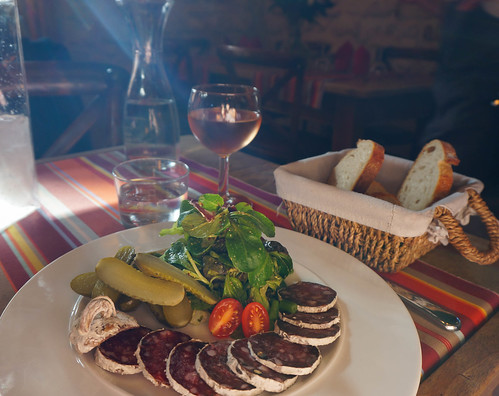
(in sunshine!)
Next, a sea bream baked in olive oil, sitting on a bed of leaks and pea pods and carrots, with a side of Camargue red rice.

And finally, warm baked apple slices, with just a dab of vanilla bean ice cream.
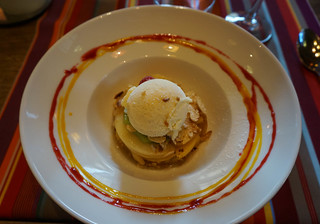
After, I walk then through the Place du Forum for the n-th time and now I finally get an angle of the yellow building that I like. What yellow building, you ask? It's the house where Van Gogh lived. Here's a snippet of his famous painting:
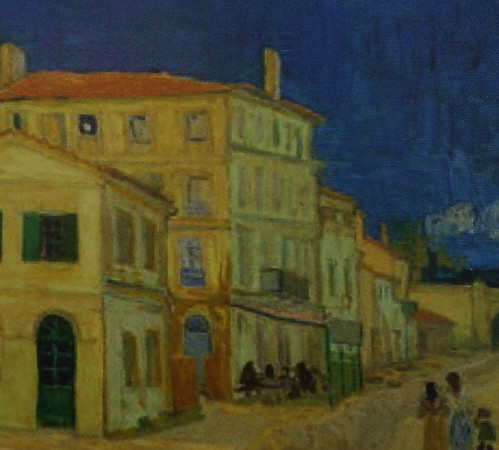
Here's the yellow house today:
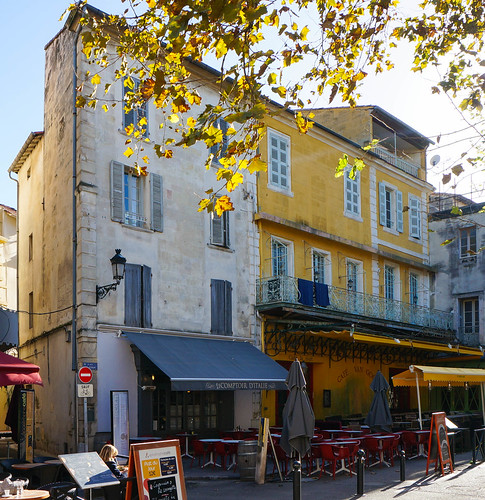
I can take in no more now. I have purchased a baguette, this time with chevre, arugula and tomato for the evening, just in case. I retreat to the B&B, take a short daytime nap (who wouldn't after all the fresh air and, too, fresh and honest food) and begin to reconstruct the day here, on Ocean.
I'll leave you with something Monsieur Cavico said to me when I told him I had retired to write:
La vie, cette une belle histoire! (life is one beautiful story)

